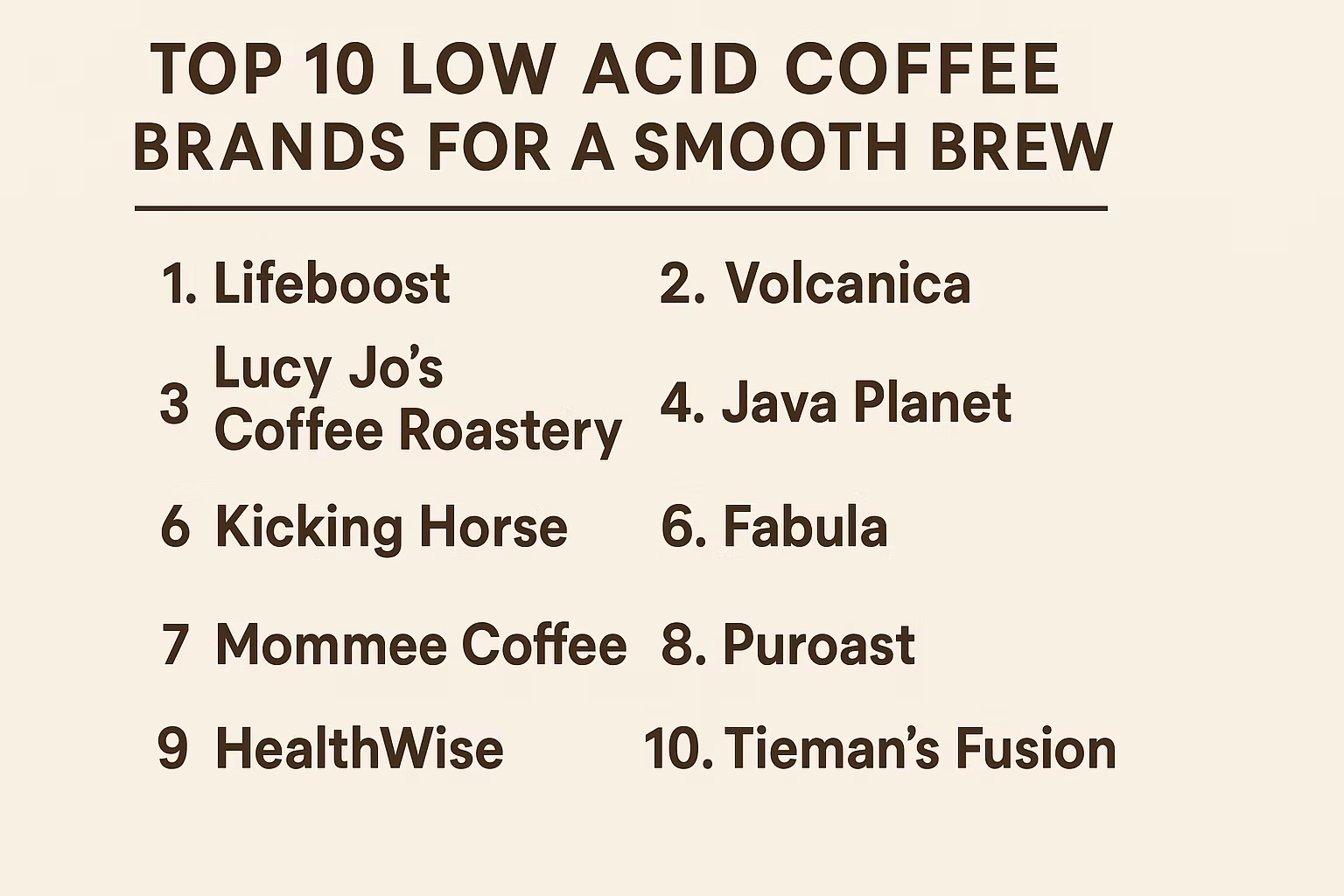Looking for the best low acid coffee brands? Discover top picks for smooth, stomach-friendly brews, plus tips on choosing low-acid beans, brewing methods, and health benefits. Perfect for acid reflux and sensitive stomach coffee lovers.
What Is Low Acid Coffee and Why It Matters
Low acid coffee is coffee that has been processed, roasted, or brewed to reduce its natural acidity. Acidity in coffee is measured by pH, with typical brews falling between pH 4.5 and 5.0. Low acid varieties typically measure closer to pH 6.0, making them gentler on the stomach. While acidity is a prized feature in specialty coffee for adding brightness and complexity, for some drinkers it’s the culprit behind acid reflux, indigestion, or tooth enamel erosion.
“Coffee doesn’t have to be punishing to be delicious,” says Dr. Mark Pimentel, gastroenterologist at Cedars-Sinai. “Low acid coffee allows sensitive coffee drinkers to enjoy the ritual without the discomfort.”
How Coffee Acidity Affects Your Body
For individuals prone to heartburn or GERD, high-acid beverages can relax the lower esophageal sphincter, allowing stomach acid to flow upward — the root cause of acid reflux symptoms. In addition, coffee’s acidity may irritate the stomach lining, especially in those with gastritis or IBS. Beyond the digestive tract, high acidity in coffee can also contribute to dental enamel wear over time, particularly for people who sip throughout the day.
Who Should Consider Low Acid Coffee
Low acid coffee isn’t just for people with diagnosed medical conditions. It’s a smart choice for:
Pregnant women seeking a gentler brew
Frequent coffee drinkers who consume multiple cups daily
Athletes or professionals looking to avoid stomach discomfort before activity
Anyone with sensitive teeth or gum issues
Travelers who want a safe coffee option abroad
Switching to a stomach-friendly coffee can often be the difference between cutting back on coffee entirely and enjoying it freely.
How to Choose the Best Low Acid Coffee Brands
With so many products labeled as “low acid” on the market, it’s important to know what to look for to ensure you’re getting a genuinely low-acid coffee bean and not just clever marketing.
Factors That Influence Coffee Acidity
Several factors determine the natural acidity of coffee:
Bean origin: Coffees grown at lower altitudes (e.g., Brazil, Sumatra) tend to be less acidic than high-altitude varieties (e.g., Ethiopian, Kenyan).
Roast level: Darker roasts generally have lower acidity due to longer roasting times breaking down acidic compounds.
Processing method: Wet-processed (washed) coffees often retain more acidity, while dry-processed (natural) or slow-fermented coffees may be smoother.
Bean variety: Certain arabica cultivars are naturally lower in acid.
Pro Tip from Lyoncafe: “For a naturally smooth cup, start with a dark roast from Sumatra or Brazil, then brew using cold water extraction to further lower acidity.” – Lyoncafe Roastery Team, 2025
Certifications and Quality Indicators
When evaluating low acid coffee brands, check for:
pH testing results on packaging or websites
USDA Organic certification for chemical-free cultivation
Fair Trade or Direct Trade practices for ethical sourcing
Swiss Water Process for decaf options without chemicals
Third-party lab testing for mycotoxins and mold
High-quality low acid coffees often come from roasters who are transparent about their sourcing and processing.
Top 10 Low Acid Coffee Brands in 2025
Our selections are based on taste tests, customer reviews, lab pH data, and ethical sourcing. These are the brands we confidently recommend for a smooth yet satisfying cup.
1. Lifeboost Coffee
Type: Single-origin Nicaraguan arabica, shade-grown, organic
pH: ~6.0
Why it stands out: Grown at high altitudes but processed to minimize acidity, this coffee is triple-tested for mycotoxins. Smooth, chocolatey, and rich, it’s a top choice for sensitive stomachs.
Best for: Black coffee drinkers who want clean, pure flavor.
2. Volcanica Low Acid Coffee
Type: Specialty low-altitude beans from Brazil and Sumatra
pH: ~5.8
Why it stands out: Offers variety — from Sumatran Mandheling to Hawaiian Kona — all with naturally low acidity. Flavor notes range from earthy to nutty.
Best for: Those who want single-origin variety without high acidity.
3. Puroast Low Acid Coffee
Type: Multiple blends and single-origins
pH: ~5.5
Why it stands out: Backed by research from the University of California, showing 70% less acidity than traditional coffee and 7x the antioxidants.
Best for: Health-conscious drinkers seeking both low acid and high antioxidant content.
4. Java Planet Organic Coffee
Type: Organic, shade-grown beans from Latin America
pH: ~5.7
Why it stands out: Certified organic and roasted in small batches for freshness, with a bold yet mellow flavor profile.
Best for: Eco-conscious consumers who prioritize organic farming.
5. Tieman’s Fusion Coffee
Type: Arabica coffee blended with matcha, rooibos, and goji berries
pH: ~5.9
Why it stands out: Innovative fusion of coffee and superfoods to balance acidity and add health benefits.
Best for: Adventurous drinkers open to a coffee-tea hybrid.
6. Mommee Coffee
Type: Organic, low-caffeine, low-acid blends
pH: ~6.0
Why it stands out: Designed specifically for pregnant women and nursing mothers, Mommee Coffee offers four caffeine levels (decaf, quarter caf, half caf, full caf) while keeping acidity minimal. USDA Organic and water-processed for safety.
Best for: Expectant or nursing mothers, or anyone looking for a gentle, customizable caffeine experience.
7. HealthWise Low Acid Coffee
Type: Colombian arabica beans processed with TechnoRoast method
pH: ~5.8
Why it stands out: This patented roasting technique reduces acids while preserving healthy antioxidants. It’s also Kosher-certified and ideal for people with digestive sensitivity.
Best for: Those who want a classic Colombian coffee taste without acidity-induced discomfort.
8. Koa Coffee Low Acid
Type: 100% Hawaiian Kona beans
pH: ~5.7
Why it stands out: Award-winning Kona coffee known for its smooth, buttery profile and low acidity. Hand-picked and sun-dried, it offers a rare premium taste experience.
Best for: Coffee connoisseurs who want both luxury and stomach-friendliness.
9. Lucy Jo’s Coffee Roastery
Type: Organic, small-batch, family-run roastery
pH: ~5.9
Why it stands out: Known for their “Mellow Belly” low acid blend, Lucy Jo’s offers a warm, earthy flavor with a hint of spice. All beans are organic and roasted to order.
Best for: Supporters of small, family-owned businesses who value freshness.
10. Café Don Pablo Subtle Earth Organic Coffee
Type: Honduran arabica, medium-dark roast
pH: ~5.8
Why it stands out: Affordable, organic, and chocolatey smooth, making it an accessible option for budget-conscious low acid coffee lovers.
Best for: Everyday drinkers who want quality organic coffee without breaking the bank.
Brewing Methods to Reduce Acidity at Home
Even if you don’t buy coffee labeled “low acid,” you can still brew in ways that naturally reduce acidity. The goal is to alter extraction conditions so fewer acidic compounds are dissolved into your cup.
Cold Brew Method
Cold brewing involves steeping coarse coffee grounds in cold water for 12–24 hours, resulting in a smooth, naturally low-acid concentrate. Studies suggest cold brew can have up to 67% less acidity than hot brewed coffee.
Steps for cold brew success:
Combine 1 cup coarse-ground coffee with 4 cups filtered water.
Steep at room temperature or in the fridge for 16–18 hours.
Strain through a fine mesh or paper filter.
Dilute concentrate to taste and serve over ice.
“Cold brew isn’t just a summer trend; it’s a health-conscious brewing choice,” notes Lyoncafe’s Head Roaster.
Paper Filter Brewing
Using paper filters (as in drip machines or pour-over) helps trap oils that contain compounds contributing to acidity and bitterness, like cafestol and kahweol.
Dark Roast vs Light Roast
Contrary to popular belief, darker roasts have lower acidity because the prolonged roasting process breaks down chlorogenic acids. If your stomach is sensitive, choose a dark roast from a naturally low-acid origin like Sumatra or Brazil.
See more: Is Coffee Good or Bad for Your Health? Science Answers
Health Benefits of Low Acid Coffee
Gentler on the Stomach
For people with acid reflux, gastritis, or GERD, low acid coffee can significantly reduce symptoms like heartburn and nausea. Harvard Health notes that lower acidity decreases the likelihood of triggering reflux episodes.
Better for Dental Health
Lower acidity helps protect enamel and reduces sensitivity, especially for people who sip coffee throughout the day. Dentists often recommend low acid varieties for long-term coffee drinkers.
Rich in Antioxidants
Low acid doesn’t mean low nutrition. Many of these brands still contain high levels of antioxidants like polyphenols, which combat oxidative stress and inflammation.
Potential Downsides and Myths
Flavor Considerations
Some coffee lovers believe lower acidity means a “flat” taste. In reality, skilled roasters can balance smoothness with complexity, producing a full-bodied cup without the sharp brightness of high-acid coffees.
Myth: Low Acid Means Low Quality
Specialty roasters now produce low acid coffees using premium beans and meticulous roasting techniques, proving that quality and smoothness can coexist. Many award-winning blends, including Koa Coffee’s Kona, are naturally low acid.
Final Verdict: Finding Your Perfect Low Acid Coffee
If acidity has ever kept you from enjoying coffee, low acid coffee brands offer an exciting solution — one that protects your stomach without sacrificing your daily ritual. Whether you choose Lifeboost Coffee for its organic purity, Puroast for its antioxidant boost, or Koa Coffee for a luxurious treat, there’s a low acid option for every palate and budget.

My name is Kara Chavez, and I love coffee. I love making the best coffees – espresso, latte, macchiato. I always strive for perfection in my barista skills, and I take great pride in bringing delicious cups of coffee to my customers.
I’ve been in the coffee industry for many years, and I know everything there is to know about brewing the perfect cup of coffee. My passion for coffee shines through in every cup I make, and I hope you’ll stop by soon so I can share my love of coffee with you!

